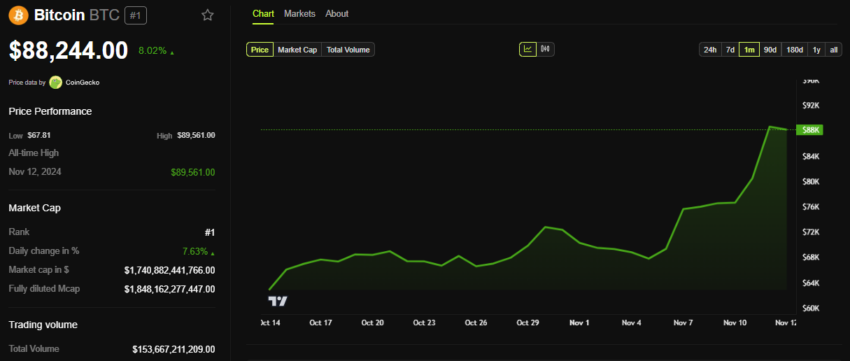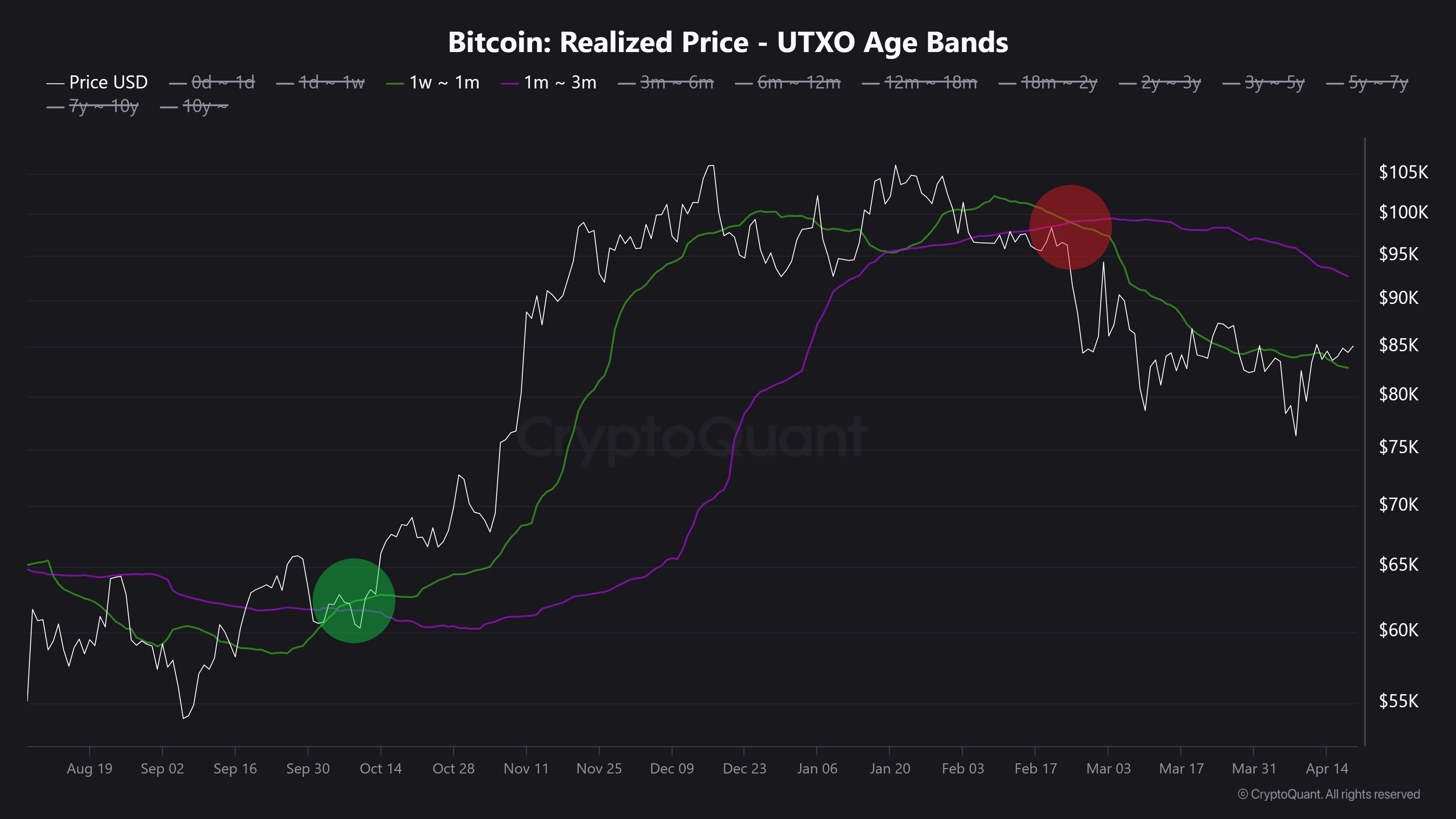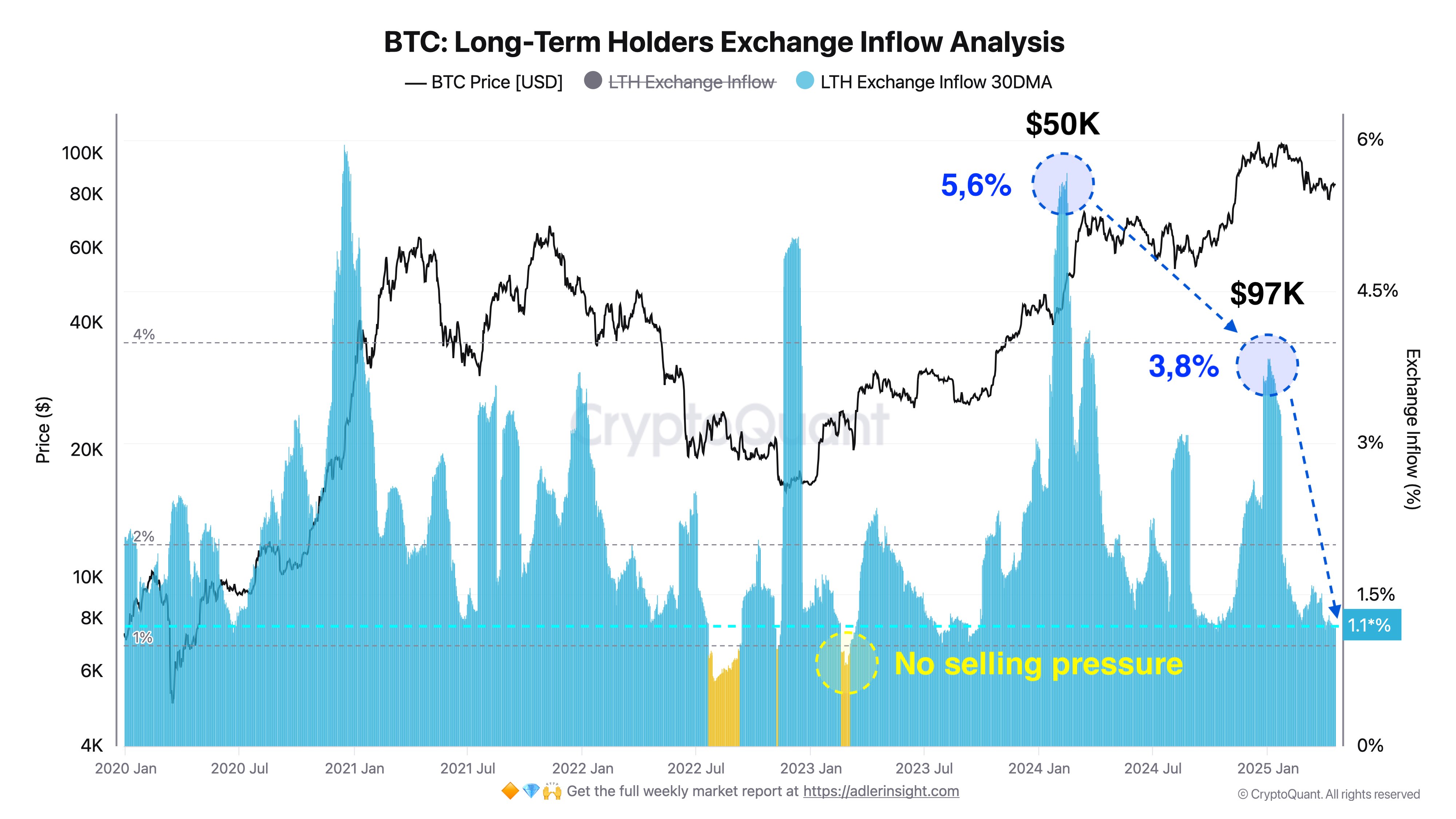Bitcoin
Peter Schiff Skeptic About Bitcoin, Quashes BTC Reserve Plans

Peter Schiff, an economist and well-known Bitcoin (BTC) critic, took to social media to voice his continued skepticism and deliver a scathing critique of the pioneer crypto’s meteoric rise.
The long-time gold proponent called the recent surge a “bubble” and warned of catastrophic consequences for investors and the economy.
Schiff Calls Bitcoin A Popular Delusion
Schiff’s criticism of Bitcoin has been longstanding. His latest remarks echo previous claims that cryptocurrency and blockchain are “popular delusions” driven by speculative fervor.
“Crypto and blockchain will likely go down as the biggest example of popular delusions and the madness of crowds in world history. The overall losses when the bubble finally pops will be staggering,” Schiff wrote on X (formerly Twitter).
He continued by warning that not just speculative buyers might suffer. In his opinion, the infrastructure and investments surrounding Bitcoin will crumble as well. This, Schiff says, would amount to what he sees as “the biggest misallocation of resources in human history.”
Schiff also suggested that Bitcoin’s collapse could tarnish the reputation of libertarian capitalism and the concept of sound money.
These comments sparked a renewed debate among his critics and Bitcoin enthusiasts, some of whom accuse him of secretly owning Bitcoin. Many believe that Schiff’s harsh criticism is merely a tactic to keep Bitcoin’s price down so he can buy in at a lower price.
“I get a kick out of Bitcoin fanatics who accuse me of secretly owning Bitcoin but refusing to publicly wear the ribbon. They are just so drunk on the Kool-Aid that they can’t accept that I legitimately disagree with their perspective,” Schiff recently responded to the allegations.
Schiff dismissed the speculation and asserted that he fundamentally disagreed with Bitcoin’s value. He views it as a bubble that will inevitably burst.
The animosity between Schiff and Bitcoin advocates is not new. He has consistently dismissed the cryptocurrency since its early days.
One user highlighted this point, accusing Schiff of predicting Bitcoin’s failure since it was priced at just $1. Schiff responded, saying, “No, when it was $1, I had no idea the bubble would ever get this big. Had I realized that back then, I would have loaded up on Bitcoin.”
This admission acknowledges the scale of Bitcoin’s price growth, though the economist continues to insist that the rise is unsustainable.
Schiff Quashes Hopes of US Bitcoin Reserve
Further, Schiff recently commented on the possibility of the US government establishing a Bitcoin reserve, as Donald Trump committed to. However, the Bitcoin critique argues that such a move would be disastrous. He notes that it would lead to a series of inflationary shocks that could destabilize the economy.
Peter Schiff’s hypothetical scenario outlines the US government purchasing one million Bitcoin, driving prices up and prompting long-term holders to cash out. According to Schiff, this would trigger a crash, compelling the government to print more money to stabilize Bitcoin’s price.
In turn, this would devalue the dollar. Schiff warns that this cycle could result in hyperinflation, rendering the dollar worthless. Ultimately, this would cause Bitcoin to collapse as well.
“That would cause the market to crash, forcing the US government to print even more dollars to buy more Bitcoin to prevent the price from crashing, thereby diminishing the value of its Bitcoin reserve. Of course, a reserve of something you can never sell and must continuously buy is worthless as a reserve. To maintain the pretense that its Bitcoin reserve has actual value, the US government would be forced to keep buying, destroying the value of the dollar in the process,” Schiff explained.
Schiff’s bleak vision of a potential Bitcoin reserve is rooted in his belief that Bitcoin lacks intrinsic value and is not a sustainable store of wealth. According to Schiff, a Bitcoin reserve would only exacerbate volatility in the market and lead to economic collapse. His apocalyptic forecast met with derision from prominent Bitcoin advocates, including MicroStrategy’s Michael Saylor, who responded to Schiff’s scenario.
“You finally made me laugh, Peter,” Saylor quipped.
The MicroStrategy executive’s jest captures the ongoing tension between Bitcoin supporters who view it as a revolutionary asset and skeptics who see it as a bubble primed to burst.
Despite the skepticism from critics like Schiff, Bitcoin’s trajectory has defied expectations over the years. It has grown from a fringe digital asset to a trillion-dollar market. Many investors and institutions like BlackRock now see it as a legitimate hedge against inflation and a decentralized alternative to traditional finance (TradFi).
Peter Schiff, however, maintains his stance that Bitcoin’s allure is based on hype rather than fundamental value. He warns that the fallout from its eventual collapse will leave a lasting impact on investors and society.

Meanwhile, Bitcoin’s value shows no signs of slowing down. It has been up by over 8% since Monday’s session opened. At the time of writing, BTC is trading for $88,244.
Disclaimer
In adherence to the Trust Project guidelines, BeInCrypto is committed to unbiased, transparent reporting. This news article aims to provide accurate, timely information. However, readers are advised to verify facts independently and consult with a professional before making any decisions based on this content. Please note that our Terms and Conditions, Privacy Policy, and Disclaimers have been updated.
Bitcoin
Here Are The Bitcoin Levels To Watch For The Short Term


Bitcoin has produced a range-bound movement recently, with prices oscillating between $83,000 and 86,000. Interestingly, popular crypto analyst Burak Kesmeci has identified the important price levels for any short-term action.
Support At 82,800, Resistance At 92,000 – But Where Is Bitcoin Headed?
In a new post on X, Kesmeci shared an interesting on-chain analysis of the Bitcoin market. Using the short-term investor cost basis, the analyst identified two key price levels that could prove critical to Bitcoin’s next major move.
Firstly, Burak Kesmeci focuses on the average cost prices of new traders over the past 1-4 weeks, which are likely the most reactive to price changes. The realized price for these traders currently stands at $82,800, forming a near-term support that indicates many recent buyers are still in profit and may defend this level as a psychological floor.
Meanwhile, Kesmeci also highlights the $92,000 price level, which marks the average cost basis for BTC holders for 1-3 months. This price point has emerged as an important resistance zone, as investors are likely to exit the market once they break even. Furthermore, the $92,000 price level is also marked by a confluence with various technical indicators.

The interplay between these two levels is significant. Historically, short-term bullish trends in BTC tend to begin when the cost basis of more recent investors, 1–4 weeks, crosses above that of the 1–3 BTC holders. This shift signals increased confidence and willingness to buy at higher levels, which often fuels broader rallies.
However, that dynamic remains to play out in the current market. As of now, Bitcoin is trading around 85,000, positioning it above its support at the 1–4 week average of $82,800 but still below the 1–3 month resistance of $92,000. Furthermore, both cost basis levels have been declining over the past two months, reflecting hesitation or a lack of aggressive buying from new entrants.
Notably, Kesmeci states that BTC must surge above $92,000 to confirm a strong bullish momentum for a price reversal.
Bitcoin ETFs Offload 1,725 BTC
In other news, Ali Martinez reports that the Bitcoin ETFs have suffered withdrawals of 1,725 Bitcoin, valued at $146.92 million, over the past week. This development illustrates a high level of negative sentiment among institutional investors, adding to market uncertainty around the BTC market.
Meanwhile, Bitcoin trades at $85,249 following a price change of 0.89% in the past day. The premier cryptocurrency also reflects a 0.58% loss on the weekly chart and a 1.06% gain on a monthly chart.
Feature image from Adobe Stock, chart from Tradingview

Editorial Process for bitcoinist is centered on delivering thoroughly researched, accurate, and unbiased content. We uphold strict sourcing standards, and each page undergoes diligent review by our team of top technology experts and seasoned editors. This process ensures the integrity, relevance, and value of our content for our readers.
Bitcoin
Bitcoin LTH Selling Pressure Hits Yearly Low — Bull Market Ready For Take Off?


Following an extensive price correction in the past three months, the Bitcoin bull market continues to hang in the balance. Despite a modest price rebound in April, the premier cryptocurrency is yet to display a strong intent to resume its bull rally amidst a lack of positive market factors. However, crypto analyst Axel Adler Jr. has highlighted a promising development that could signal major upside potential for Bitcoin.
Bitcoin Long-Term Holders Looking To Halt Selling Pressure
In a recent post on X, Adler Jr. shared an important update in Bitcoin long-term holders (LTH) activity, which could prove significantly positive for the broader BTC market.
Using on-chain data from CryptoQuant, the renowned analyst reports that selling pressure by long-term holders, i.e. amount of LTH holdings on exchanges, has now hit its lowest point at 1.1% over the past year. This development indicates that Bitcoin LTH are now opting to hold on to their assets rather than take profits.

Adler explains that a further decline in these LTH exchange holdings to 1.0% would signal the total absence of selling pressure. Notably, this development could encourage new market entry and sustained accumulation, creating a strong bullish momentum in the BTC market.
Importantly, Alder highlights that the majority of the Bitcoin LTH entered the market at an average price of $25,000, Since then, CryptoQuant has recorded the highest LTH selling pressure of 5.6% at $50,000 in early 2024 and 3.8% at $97,000 in early 2025.
According to Adler, these two instances likely represent the primary profit-taking phases for long-term holders who intended to exit the market. Therefore, a resurgence in selling pressure from this cohort of BTC investors is unlikely in the short-term, which supports a building bullish case as long-term holders currently control 77.5% of Bitcoin in circulation.
BTC Price Overview
At the time of writing, Bitcoin was trading at $85,226 following a 0.36% gain in the past day and a 0.02% loss in the past week. Both metrics only reflect the ongoing market consolidation as BTC continues to struggle to achieve a convincing price breakout beyond $86,000.
Meanwhile, the asset’s performance on the monthly chat now reflects a 1.97% gain, indicating a potential trend reversal as the market correction ceases. Nevertheless, BTC remains in need of a strong market catalyst to ignite any sustainable price rally. With a market cap of $1.67 trillion, Bitcoin is ranked as the largest digital asset, controlling 62.9% of the crypto market.
Featured image from Adobe Stock, chart from Tradingview

Editorial Process for bitcoinist is centered on delivering thoroughly researched, accurate, and unbiased content. We uphold strict sourcing standards, and each page undergoes diligent review by our team of top technology experts and seasoned editors. This process ensures the integrity, relevance, and value of our content for our readers.
Bitcoin
Analyst Says Bitcoin Price Might Be Gearing Up For Next Big Move — What To Know


The Bitcoin price seems stuck in a consolidation range, ricocheting off the $83,000 and $86,000 levels over the past week. With no clear direction for the premier cryptocurrency, investors are left wondering what phase the market cycle is in—bullish or bearish.
According to a popular crypto analyst on the social media platform X, the Bitcoin price could be preparing for its next big move in either direction over the next few weeks. In any case, here are the important levels to watch out for in the next few days.
Crucial Levels To Watch For BTC’s Next Move
In an April 19 post on the X platform, crypto analyst Ali Martinez shared an interesting analysis of the Bitcoin price while highlighting the current layout of the world’s largest cryptocurrency by market cap. The online pundit noted that BTC bears and bulls are locked in a battle, leading to a choppy market condition.
Notably, the premier cryptocurrency appears to have entered the $83,000 – $86,000 range on Saturday, April 12. Hence, Martinez’s analysis basically revolves around the price of BTC bouncing off the support and resistance levels on its one-hour timeframe.
Source: @ali_charts on X
As shown in the chart above, the Bitcoin price attempted multiple times to breach the resistance zone around the $86,000 region over the past week. However, the bulls’ optimism was met with the staunch resilience of the Bitcoin bears, as the price of BTC almost always found its way back toward the $83,000 mark.
Most recently, the flagship cryptocurrency made its way toward the $86,000 level on Wednesday, April 16, but failed to break the significant resistance zone after the US Federal Reserve (Fed) chair Jerome Powell suggested that interest rate cuts might not be coming as early as anticipated by crypto traders.
Martinez noted in his post that the next significant move for the Bitcoin price depends primarily on the $83,000 and $86,000 levels. According to the crypto pundit, a breakout above the $86,000 mark could spell the start of a bullish run for Bitcoin, while a break below $83,000 could mean further correction for the market leader.
Bitcoin Price Overview
After reaching its all-time high of $108,786 in January 2025, the price of BTC has been on a steady decline in the past few months. According to data from CoinGecko, the flagship cryptocurrency has losst more than 22% of its value since hitting its record-high price.
As of this writing, the price of Bitcoin stands at around $84,530, reflecting a 0.3% decline in the past 24 hours. Meanwhile, the Bitcoin price is up by more than 1% on the weekly timeframe.
The price of BTC on the daily timeframe | Source: BTCUSDT chart on TradingView
Featured image from iStock, chart from TradingView

Editorial Process for bitcoinist is centered on delivering thoroughly researched, accurate, and unbiased content. We uphold strict sourcing standards, and each page undergoes diligent review by our team of top technology experts and seasoned editors. This process ensures the integrity, relevance, and value of our content for our readers.
-

 Altcoin20 hours ago
Altcoin20 hours agoUniswap Founder Urges Ethereum To Pursue Layer 2 Scaling To Compete With Solana
-

 Ethereum16 hours ago
Ethereum16 hours agoEthereum Consolidates In Symmetrical Triangle: Expert Predicts 17% Price Move
-

 Altcoin19 hours ago
Altcoin19 hours agoWhat’s Up With BTC, XRP, ETH?
-

 Market16 hours ago
Market16 hours agoToday’s $1K XRP Bag May Become Tomorrow’s Jackpot, Crypto Founder Says
-

 Bitcoin23 hours ago
Bitcoin23 hours agoAnalyst Says Bitcoin Price Might Be Gearing Up For Next Big Move — What To Know
-

 Market10 hours ago
Market10 hours ago1 Year After Bitcoin Halving: What’s Different This Time?
-

 Ethereum18 hours ago
Ethereum18 hours agoEthereum Accumulators At A Crucial Moment: ETH Realized Price Tests Make-Or-Break Point
-

 Altcoin23 hours ago
Altcoin23 hours agoExpert Reveals Why Consensus 2025 Will Be Pivotal For Pi Network


















